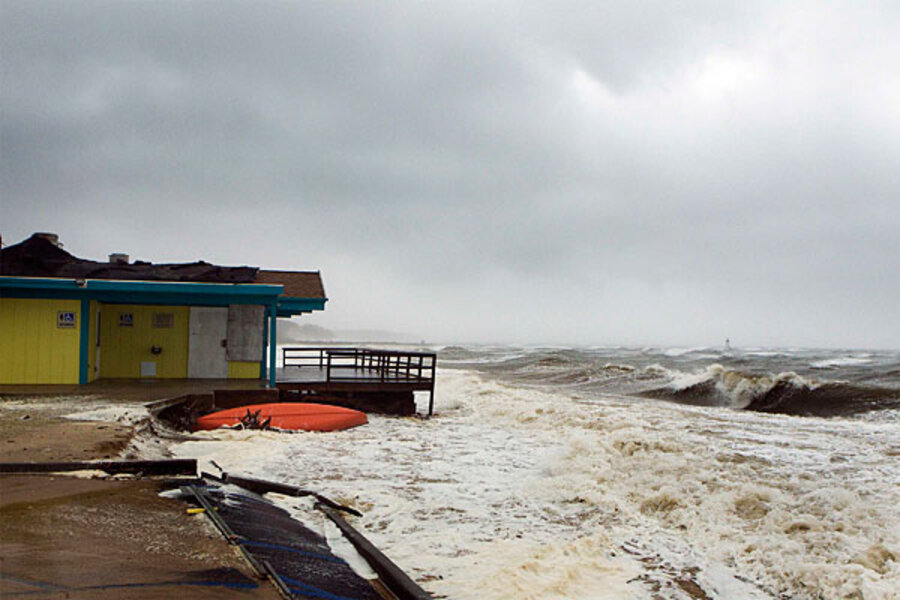Hurricane Sandy surge could flood New York runways and subways
Loading...
| New York
Storm experts say the worst damage from hurricane Sandy is likely to be from the storm surge, a wall of water that will sweep in with the high tide, engulfing homes, businesses, and anything else in its way.
The surge pushed ashore by the storm could be as high as 13 feet in places such as Stamford, Conn., and Staten Island, N.Y., according to estimates from the National Oceanic and Atmospheric Administration (NOAA). Full-moon tides could add another foot, and near-hurricane-force wind gusts could produce 20-foot waves.
Experts say the surge could put some runways at New York-area airports under water and perhaps flood New York subways with seawater, leading to costly electrical damage.
“The surge is going to be near-record and, in a few places, record levels,” says James Aman, a meteorologist at Earth Networks, the parent of the Weather Bug.
The implications of a large surge are that some shoreline communities could be flooded, possibility resulting in life-threatening situations for residents who did not evacuate.
On Monday, Norwalk, Conn., residents Fred and Lisa Clarke left their home on the Norwalk River just in time.
“We left a little before high tide, and water was just crashing over the sea wall,” says Mr. Clarke. “There was only one road out from our house, and we just barely made it.”
On Monday morning at a press conference, Connecticut Gov. Dannel Malloy implored residents to evacuate before the worst of the storm hit. He said the storm would bring two times more water into Long Island Sound than hurricane Irene.
The two most worrisome areas, says Mr. Aman, are western Long Island Sound, especially around LaGuardia airport, and Raritan Bay, which is close to Newark airport in New Jersey. “The latest NOAA information indicates there could be a 13 foot surge in those areas,” he says. “That would put part of the runways under water.”
The prospect of a surge of water prompted New York to shut down its subway service and close the Holland Tunnel and the Brooklyn Battery Tunnel. On Monday, Mayor Bloomberg said bus and subway service would be shut down on Tuesday, as well. Financial markets will be closed for a second consecutive day Tuesday.
If water gets into the subways and tunnels, the impact could be even longer lasting – electrical conduits could be submerged, which could corrode them. In that case, the damage could be very expensive to repair.
The storm surge was expected to extend into southern New England in places such as Rhode Island.
“A lot of places that have never been flooded before are likely to be flooded,” said Elizabeth Roberts, the lieutenant governor of Rhode Island in an interview on the Weather Channel.
The storm surge is influenced by several factors:
- Low pressure can exacerbate a storm surge. “The lower the pressure, the bigger the surge,” says Howard Botts, an expert on storm surges and a vice president at CoreLogic, an Irvine, Calif.-based real estate information company. In the case of Sandy, the pressures are among the lowest recorded for a storm north of North Carolina's Cape Hatteras.
- As the water accumulates around the storm, the forward speed of the hurricane acts like a plow to push water in front. A large wind field can exacerbate the impact, as is the case with Sandy. Making the surge even worse for New York, the city is on the right hand side of the storm, which is usually the windiest part, pushing the most water.
- The geography can also play a role – and that appears to be working against New York, too. The water is being funneled down Long Island Sound, where there is little opportunity for it to escape. It will just pile up, increasing the flooding. The same is true along the south side of Long Island – the water is getting shoved into Raritan Bay, close to Newark airport.
Once the surge finally drains back into the sea, experts anticipate the cost will be in the billions.
“Hurricane Irene was a $19 billion storm with most of the damage done in the interior,” says Mr. Botts. Sandy “is likely to top that number.”
Many homeowners who live on the water are expecting the worst. Last year, when hurricane Irene hit, the Clarkes had water in the ground floor of their home. It took weeks to clean up.
Now, Mr. Clarke says he expects a six- to nine-foot surge with the possibility of six-foot waves. Even though he and his wife spent three days trying to board up the house, he is resigned to seeing a lot of damage.
“With 10 feet of water, we are talking about the entire family room covered with water,” he says. “With six-foot waves, we are talking about water reaching into the master bedroom on the second floor,” he says. “I don’t know if the house will be there when we finally get back in.”







